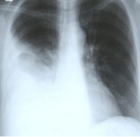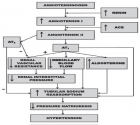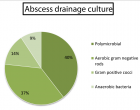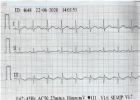Abstract
Research Article
“Iliosacral bridging” - A new alternative minimal invasive fixation of unstable pelvic ring fractures
Siekmann H*, Becherer L, Neef R, Kunath T and Florian Radetzki
Published: 20 November, 2018 | Volume 2 - Issue 2 | Pages: 039-046
Introduction: Fractures of both the anterior and posterior pelvic ring are common injuries in polytrauma and the elderly that extend beyond those of simple low-impact trauma. While conventional X-rays predominantly show the ventral aspect of the injury, computed tomography often detect additional fractures of the sacrum. A large number of these fractures are B-injuries by AO, mainly compression fractures at an advanced age. In addition, the prevalence of pelvic insufficiency fractures caused by osteoporosis rather than subsequent to an obvious trauma is increasing, with such an injury often associated with pain that impairs mobilization. The standard sacroiliac screw fixation is often characterized by loosening and thus failure of the osteosynthesis especially in osteoporotic bone of elderly patients.
Method: A new alternative surgical minimal invasive technique, the “iliosacral bridging”, stabilizes the fractures of the sacrum with an internal fixation from S1 pedicle of the uninjured side to the ilium on the affected side. The combination of this internal fixation with the standard single sacroiliac screw on the injured side allows an immediate full weight bearing and pain free mobilization. We present a case series of 8 patients.
Results: The clinical and radiological analysis analogous to the pelvic-outcome-score brought forward that 2 patients showed an excellent and 2 patient a good result. The other 4 patients achieved sufficient results.
Conclusions: The “iliosacral bridging” we have introduced in the present study provides evidence of an expected increased stability of the pelvis after B-injuries
Read Full Article HTML DOI: 10.29328/journal.ascr.1001022 Cite this Article Read Full Article PDF
Keywords:
Pelvis; Pelvic ring; Osteoporotic fracture; Insufficiency fracture; Classification; Treatment; Osteosynthesis; Iliosacral bridging; Transsacral bar; Iliolumbar fixation; Sacroiliac screw
References
- Gilliland MD, Ward RE, Barton RM, Miller PW, Duke JH. Factors affecting mortality in pelvic fractures. J Trauma 1982; 22: 691-693. Ref.: https://goo.gl/MkAo1t
- Keller JM, Sciadini MF, Sinclair E, O'Toole RV. Geriatric trauma demographics, injuries, and mortality. J Orthop Trauma. 2012; 26: e161-e165. Ref.: https://goo.gl/2tmKuj
- Rommens PM, Hofmann A. Comprehensive classification of fragility fractures of the pelvic ring: Recommendations for surgical treatment. Injury. 2013; 44: 1733-1744. Ref.: https://goo.gl/6Jo4xn
- Sullivan MP, Baldwin KD, Donegan DJ, Mehta S, Ahn J. Geriatric fractures about the hip: divergent patterns in the proximal femur, acetabulum, and pelvis. Orthopedics. 2014; 37: 151-157. Ref.: https://goo.gl/27u3TS
- Frick H, Leonhardt H, Starck D. Taschenlehrbuch der gesamten Anatomie I. Allgemeine Anatomie. Spezielle Anatomie I. Extremitäten, Rumpfwand, Kopf, Hals. Mit Schlüssel zum Gegenstandskatalog. 4. Auflage ed. Stuttgart: Thieme 1992;
- Galbraith JG, Butler JS, Blake SP, Kelleher G. Sacral insufficiency fractures: an easily overlooked cause of back pain in the ED. Am J Emerg Med 2011; 29: 359-356. Ref.: https://goo.gl/95dD72
- White JH, Hague C, Nicolaou S, Gee R, Marchinkow LO, et al. Imaging of sacral fractures. Clin Radiol 2003; 58: 914-921. Ref.: https://goo.gl/EXMwzq
- Cabarrus MC, Ambekar A, Lu Y, Link TM. MRI and CT of insufficiency fractures of the pelvis and the proximal femur. AJR Am J Roentgenol. 2008; 191: 995-1001. Ref.: https://goo.gl/iNyzzz
- Ahovuo JA, Kiuru MJ, Visuri T. Fatigue stress fractures of the sacrum: diagnosis with MR imaging. Eur Radiol. 2004; 14: 500-505. Ref.: https://goo.gl/j3WRZK
- Pohlemann T, Gansslen A, Tscherne H. [Fracture of the sacrum]. Unfallchirurg. 2000; 103: 769-786.
- Denis F, Davis S, Comfort T. Sacral fractures: an important problem. Retrospective analysis of 236 cases. Clin Orthop Relat Res. 1988; 227: 67-81. Ref.: https://goo.gl/oFzSa6
- Koo H, Leveridge M, Thompson C, Zdero R, Bhandari M, et al. Interobserver reliability of the young-burgess and tile classification systems for fractures of the pelvic ring. J Orthop Trauma. 2008; 22: 379-384. Ref.: https://goo.gl/FdTrAh
- Tile M. Fractures of the pelvis and acetabulum. 2nd ed. Baltimore: Williams & Wilkins. 1995;
- Giannoudis PV, Tzioupis CC, Pape HC, Roberts CS. Percutaneous fixation of the pelvic ring: an update. J Bone Joint Surg Br. 2007; 89: 145-154. Ref.: https://goo.gl/ugZ9fC
- Grubor P, Milicevic S, Biscevic M, Tanjga R. Selection of treatment method for pelvic ring fractures. Med Arh. 2011; 65: 278-282. Ref.: https://goo.gl/fg9Fpp
- Mendel T, Noser H, Wohlrab D, Stock K, Radetzki F. The lateral sacral triangle--a decision support for secure transverse sacroiliac screw insertion. Injury. 2011; 42: 1164-1170. Ref.: https://goo.gl/BYkYk2
- Babayev M, Lachmann E, Nagler W. The controversy surrounding sacral insufficiency fractures: to ambulate or not to ambulate? Am J Phys Med Rehabil. 2002; 79: 404-409. Ref.: https://goo.gl/5BaEo9
- Matta JM, Saucedo T. Internal fixation of pelvic ring fractures. Clin Orthop Relat Res. 1989; (242): 83-97. Ref.: https://goo.gl/pyS5f9
- Mears SC, Sutter EG, Wall SJ, Rose DM, Belkoff SM. Biomechanical comparison of three methods of sacral fracture fixation in osteoporotic bone. Spine (Phila Pa 1976) 2010; 35: E392-E395. Ref.: https://goo.gl/BL36ZJ
- Routt ML, Jr., Simonian PT, Agnew SG, Mann FA. Radiographic recognition of the sacral alar slope for optimal placement of iliosacral screws: a cadaveric and clinical study. J Orthop Trauma. 1996; 10: 171-177. Ref.: https://goo.gl/yE2LAc
- Carlson DA, Scheid DK, Maar DC, Baele JR, Kaehr DM. Safe placement of S1 and S2 iliosacral screws: the "vestibule" concept. J Orthop Trauma. 2000; 14: 264-269. Ref.: https://goo.gl/rfuBAW
- Tosounidis T, Kanakaris N, Nikolaou V, Tan B, Giannoudis PV. Assessment of Lateral Compression type 1 pelvic ring injuries by intraoperative manipulation: which fracture pattern is unstable? Int Orthop. 2012; 36: 2553-2558. Ref.: https://goo.gl/YUACk3
- van Zwienen CM, van den Bosch EW, Snijders CJ, Kleinrensink GJ, van Vugt AB. Biomechanical comparison of sacroiliac screw techniques for unstable pelvic ring fractures. J Orthop Trauma. 2004; 18: 589-595. Ref.: https://goo.gl/uFxqzv
- Wahnert D, Raschke MJ, Fuchs T. Cement augmentation of the navigated iliosacral screw in the treatment of insufficiency fractures of the sacrum: a new method using modified implants. Int Orthop. 2013; 37: 1147-1150. Ref.: https://goo.gl/huSi7G
- Yu BS, Yang ZK, Li ZM, Zeng LW, Wang LB, et al. Which is the preferred revision technique for loosened iliac screw? A novel technique of boring cement injection from the outer cortical shell. J Spinal Disord Tech. 2011; 24: E49-E56. Ref.: https://goo.gl/LLbNyp
- Frey ME, DePalma MJ, Cifu DX, Bhagia SM, Carne W, et al. Percutaneous sacroplasty for osteoporotic sacral insufficiency fractures: a prospective, multicenter, observational pilot study. Spine J. 2008; 28: 367-373. Ref.: https://goo.gl/3nKGW6
- Shah RV. Sacral kyphoplasty for the treatment of painful sacral insufficiency fractures and metastases. Spine J. 2012; 12: 113-120. Ref.: https://goo.gl/Jv47Pq
- Trouvin AP, Alcaix D, Somon T, Zarnitsky C. Analgesic effect of sacroplasty in osteoporotic sacral fractures: a study of six cases. Joint Bone Spine. 2012; 79: 500-503. Ref.: https://goo.gl/HvHbBp
- Bastian JD, Keel MJ, Heini PF, Seidel U, Benneker LM. Complications related to cement leakage in sacroplasty. Acta Orthop Belg. 2012; 78:100-105. Ref.: https://goo.gl/PyCKdW
- Pohlemann T, Weigel B, Maghsudi M. Praxisbuch Unfallchirurgie. 2nd ed. Berlin, Heidelberg, NY: Springer. 2011;
- Schildhauer TA, Josten C, Muhr G. riangular osteosynthesis of vertically unstable sacrum fractures: a new concept allowing early weight-bearing. J Orthop Trauma.1998; 12: 307-314. Ref.: https://goo.gl/V7LZw9
- Schildhauer TA, McCulloch P, Chapman JR, Mann FA. Anatomic and radiographic considerations for placement of transiliac screws in lumbopelvic fixations. J Spinal Disord Tech. 2002; 15: 199-205. Ref.: https://goo.gl/wx7gXb
- Ebraheim NA, Lin D, Xu R, Stanescu S, Yeasting RA. Computed tomographic evaluation of the internal structure of the lateral sacral mass in the upper sacra. Orthopedics.1999; 22: 1137-1140. Ref.: https://goo.gl/vof6rG
Figures:
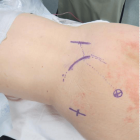
Figure 1
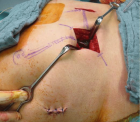
Figure 2

Figure 3
Similar Articles
-
Bouveret Syndrome in an Elderly FemaleZvi H. Perry*, Udit Gibor,Shahar Atias,Solly Mizrahi,Alex Rosental, Boris Kirshtein. Bouveret Syndrome in an Elderly Female . . 2017 doi: 10.29328/journal.ascr.1001002; 1: 012-015
-
Intestinal obstruction complicated by large Morgagni herniaMartín Arnau B*,Medrano Caviedes R,Rofin Serra S, Caballero Mestres F,Trias Folch M. Intestinal obstruction complicated by large Morgagni hernia . . 2017 doi: 10.29328/journal.ascr.1001003; 1: 016-020
-
The revolution of cardiac surgery evolution Running head: Cardiac surgery evolutionMarzia Cottini*. The revolution of cardiac surgery evolution Running head: Cardiac surgery evolution . . 2017 doi: 10.29328/journal.ascr.1001007; 1: 049-050
-
Thirty days post-operative complications after Sleeve Gastrectomy, Gastric Bypass and Mini Gastric Bypass/one Anastomosis Gastric Bypass. Analysis of the Italian Society for Bariatric Surgery and Metabolic Disorders (S.I.C.OB.) database of 7 years time frameMaurizio De Luca*,Nicola Clemente,Cristiana Visentin,Natale Pellicanò,Cesare Lunardi,Alberto Sartori,Gianni Segato,Luigi Angrisani,Marcello Lucchese5,Nicola Di Lorenzo. Thirty days post-operative complications after Sleeve Gastrectomy, Gastric Bypass and Mini Gastric Bypass/one Anastomosis Gastric Bypass. Analysis of the Italian Society for Bariatric Surgery and Metabolic Disorders (S.I.C.OB.) database of 7 years time frame. . 2017 doi: 10.29328/journal.ascr.1001011; 1: 062-071
-
New era of liver transplantation for HIV-HCV Co-infected patients: A case reportKonstantinos A Zorbas*,Sunil S Karhadkar,Kwan N Lau,Andreas Karachristos,Antonio Di Carlo. New era of liver transplantation for HIV-HCV Co-infected patients: A case report. . 2017 doi: 10.29328/journal.ascr.1001012; 1: 072-076
-
Safety and effectiveness of laparoscopic management in 210 patients with erosion of adjustable Gastric bandingRamiro Galvez-Valdovinos*,Juan francisco Funes-Rodriguez,Ernesto Marin Y Santillan,Gustavo López Ambriz,Juan Francisco Ramirez-Arias. Safety and effectiveness of laparoscopic management in 210 patients with erosion of adjustable Gastric banding. . 2017 doi: 10.29328/journal.ascr.1001013; 1: 077-082
-
Role of Helicobacter pylori in causing repeated Reinfection from Oral cavity in Chronic ProstatitisPankaj Garg*. Role of Helicobacter pylori in causing repeated Reinfection from Oral cavity in Chronic Prostatitis. . 2018 doi: 10.29328/journal.ascr.1001014; 2: 001-004
-
Scrotal Hydroceles not associated with Patent Processus Vaginalis in ChildrenMasao Endo*,Fumiko Yoshida,Masaharu Mori,Miwako Nakano,Toshiya Morimura,Yasuharu Ohno,Makoto Komura. Scrotal Hydroceles not associated with Patent Processus Vaginalis in Children. . 2018 doi: 10.29328/journal.ascr.1001015; 2: 005-012
-
The Essential Role of Esophagogastroduodenoscopy Prior to bariatric surgeryReza Ebrahimi, Mohammad Kermansaravi, Abdolreza Pazouki*. The Essential Role of Esophagogastroduodenoscopy Prior to bariatric surgery. . 2018 doi: 10.29328/journal.ascr.1001016; 2: 013-014
-
Gossypiboma due to a retained surgical sponge following abdominal hysterectomy, complicated by intestinal migration and small bowel obstruction- A Case ReportVivek Agrawal,Praroop Gupta*. Gossypiboma due to a retained surgical sponge following abdominal hysterectomy, complicated by intestinal migration and small bowel obstruction- A Case Report. . 2018 doi: 10.29328/journal.ascr.1001017; 2: 015-017
Recently Viewed
-
Treatment Outcome in Patients with Myofascial Orofacial Pain: A Randomized Clinical TrialAnders Wänman*, Susanna Marklund, Negin Yekkalam. Treatment Outcome in Patients with Myofascial Orofacial Pain: A Randomized Clinical Trial. J Oral Health Craniofac Sci. 2024: doi: 10.29328/journal.johcs.1001046; 9: 001-008
-
Hygiene and Care Protocols for Implant-supported Dental Prostheses in Patients with DiabetesHakob Khachatryan, Emma Boshnaghyan, Sevak Papoyan, Gagik Hakobyan*. Hygiene and Care Protocols for Implant-supported Dental Prostheses in Patients with Diabetes. J Oral Health Craniofac Sci. 2024: doi: 10.29328/journal.johcs.1001047; 9: 009-014
-
Advancing Oral Health and Craniofacial Science through Microchip ImplantsShekufeh Shafeie*. Advancing Oral Health and Craniofacial Science through Microchip Implants. J Oral Health Craniofac Sci. 2024: doi: 10.29328/journal.johcs.1001048; 9: 015-018
-
Texture Analysis of Hard Tissue Changes after Sinus Lift Surgery with Allograft and XenograftMohammad Azimzadeh, Farzad Esmaeili, Narges Bayat, Kasra Rahimipour, Amir Ebrahimpour Tolouei*. Texture Analysis of Hard Tissue Changes after Sinus Lift Surgery with Allograft and Xenograft. J Oral Health Craniofac Sci. 2024: doi: 10.29328/journal.johcs.1001049; 9: 019-022
-
Awareness and Knowledge of Specialists/Trainers and General Dental Practitioners about Medical-Related Osteonecrosis of the JawsAbdulhamit Taha Koca,Mustafa Bayhan,Yunus Ayberk Demir,Ayse Zeynep Zengin*. Awareness and Knowledge of Specialists/Trainers and General Dental Practitioners about Medical-Related Osteonecrosis of the Jaws. J Oral Health Craniofac Sci. 2024: doi: 10.29328/journal.johcs.1001050; 9: 023-031
Most Viewed
-
Evaluation of Biostimulants Based on Recovered Protein Hydrolysates from Animal By-products as Plant Growth EnhancersH Pérez-Aguilar*, M Lacruz-Asaro, F Arán-Ais. Evaluation of Biostimulants Based on Recovered Protein Hydrolysates from Animal By-products as Plant Growth Enhancers. J Plant Sci Phytopathol. 2023 doi: 10.29328/journal.jpsp.1001104; 7: 042-047
-
Sinonasal Myxoma Extending into the Orbit in a 4-Year Old: A Case PresentationJulian A Purrinos*, Ramzi Younis. Sinonasal Myxoma Extending into the Orbit in a 4-Year Old: A Case Presentation. Arch Case Rep. 2024 doi: 10.29328/journal.acr.1001099; 8: 075-077
-
Feasibility study of magnetic sensing for detecting single-neuron action potentialsDenis Tonini,Kai Wu,Renata Saha,Jian-Ping Wang*. Feasibility study of magnetic sensing for detecting single-neuron action potentials. Ann Biomed Sci Eng. 2022 doi: 10.29328/journal.abse.1001018; 6: 019-029
-
Pediatric Dysgerminoma: Unveiling a Rare Ovarian TumorFaten Limaiem*, Khalil Saffar, Ahmed Halouani. Pediatric Dysgerminoma: Unveiling a Rare Ovarian Tumor. Arch Case Rep. 2024 doi: 10.29328/journal.acr.1001087; 8: 010-013
-
Physical activity can change the physiological and psychological circumstances during COVID-19 pandemic: A narrative reviewKhashayar Maroufi*. Physical activity can change the physiological and psychological circumstances during COVID-19 pandemic: A narrative review. J Sports Med Ther. 2021 doi: 10.29328/journal.jsmt.1001051; 6: 001-007

HSPI: We're glad you're here. Please click "create a new Query" if you are a new visitor to our website and need further information from us.
If you are already a member of our network and need to keep track of any developments regarding a question you have already submitted, click "take me to my Query."







